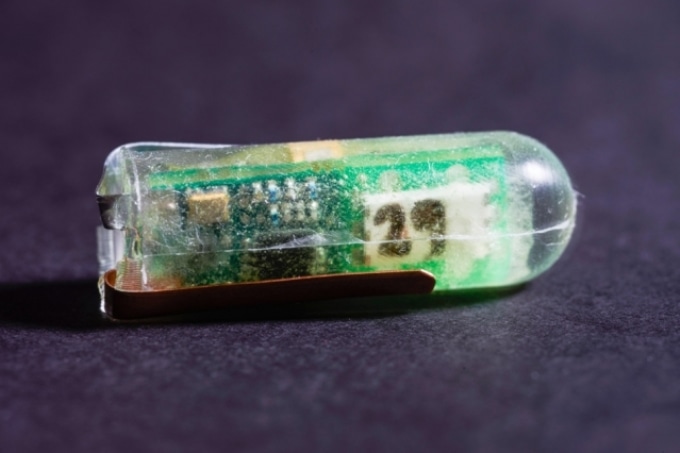Feb 7 2017
 Researchers at MIT and Brigham and Women�s Hospital have designed and demonstrated a small, ingestible voltaic cell that is sustained by the acidic fluids in the stomach. (Photo: Diemut Strebe)
Researchers at MIT and Brigham and Women�s Hospital have designed and demonstrated a small, ingestible voltaic cell that is sustained by the acidic fluids in the stomach. (Photo: Diemut Strebe)
A tiny voltaic cell sustained by the acidic fluids found in the stomach was designed and demonstrated by a team of researchers from MIT and Brigham and Women’s Hospital.
It is capable of producing enough power to run drug delivery devices or small sensors placed inside the gastrointestinal tract for long periods of time.
The researchers explain that this sort of power would be a safer and more economical option compared to the traditional batteries currently used to power such devices.
We need to come up with ways to power these ingestible systems for a long time. We see the GI tract as providing a really unique opportunity to house new systems for drug delivery and sensing, and fundamental to these systems is how they are powered.
Giovanni Traverso, Research Affiliate, Koch Institute for Integrative Cancer Research
Traverso, who is also a gastroenterologist and biomedical engineer at Brigham and Women’s Hospital, is one of the senior authors of the study. The others are Robert Langer, the David H. Koch Institute Professor at MIT; and Anantha Chandrakasan, head of MIT’s Department of Electrical Engineering and Computer Science and the Vannevar Bush Professor of Electrical Engineering and Computer Science. MIT postdoc Phillip Nadeau is the lead author of the paper, which is published in the February 6 issue of Nature Biomedical Engineering.
Sustained by Acid
Traverso and Langer have previously constructed and tested several ingestible devices that can be used to deliver drugs to treat diseases such as malaria, or to monitor physiological conditions such as heart rate, temperature, and breathing rate.
This work could lead to a new generation of electronic ingestible pills that could someday enable novel ways of monitoring patient health and/or treating disease.
Robert Langer, MIT
These devices are typically powered by tiny batteries, but traditional batteries self-discharge over time and are a potential safety risk. To find a solution to these issues, Langer and Traverso partnered with Nadeau and Chandrakasan, who are experts in building low-power electronics.
The research team drew inspiration from a basic type of voltaic cell called a lemon battery, which has two electrodes - a copper penny and a galvanized nail in most cases - stuck in a lemon. The lemon’s citric acid transmits a small electric current between the two electrodes.
To replicate that model, the team attached copper and zinc electrodes to the surface of their ingestible sensor. The zinc releases ions into the stomach acid to power the voltaic circuit, producing sufficient energy to power a 900-megahertz transmitter and a standard temperature sensor.
When tested on pigs, the devices took about six days to move through the digestive tract. When in the stomach, the voltaic cell generated sufficient energy to power a temperature sensor and to wirelessly convey the data to a base station postioned 2 m away, with a signal transmitted every 12 seconds.
Once the device entered into the small intestine, which contains less acid compared to the stomach, the cell produced only roughly 1/100 of what it generated in the stomach. “But there’s still power there, which you could harvest over a longer period of time and use to transmit less frequent packets of information,” Traverso says.
This paper reports an exciting and remarkably broad collection of advances in ‘ingestible’ electronics - from bioresorbable power supplies to energy efficient electronics, advanced sensors/actuators, and wireless communication systems. These types of systems have great potential to address important clinical needs.
John Rogers, Professor, Northwestern University
Miniaturization
The latest prototype of the device is a cylinder approximately 40 mm long and 12 mm in diameter, but the researchers predict that they could create a capsule roughly one-third that size by constructing a tailor-made integrated circuit that would carry the transmitter, the energy harvester, and a small microprocessor.
A big challenge in implantable medical devices involves managing energy generation, conversion, storage, and utilization. This work allows us to envision new medical devices where the body itself contributes to energy generation enabling a fully self-sustaining system.
Anantha Chandrakasan, MIT
When the researchers achieve miniaturization of the device, they hope to incorporate other types of sensors and develop it for applications such as continual monitoring of vital signs.
“You could have a self-powered pill that would monitor your vital signs from inside for a couple of weeks, and you don’t even have to think about it. It just sits there making measurements and transmitting them to your phone,” Nadeau says.
Such devices could also be applied in drug delivery. In this research, the team showed that they could use the power produced by the voltaic cell to discharge drugs encapsulated by a gold film. This could be helpful for situations in which doctors have to try out varied drug dosages, such as medication for blood pressure control.
The research received funding from Texas Instruments, the Semiconductor Research Corporation’s Center of Excellence for Energy Efficient Electronics, the Hong Kong Innovation and Technology Commission, the National Institutes of Health, and the Max Planck Research Award.